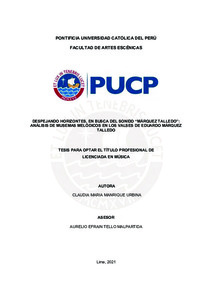| dc.contributor.advisor | Tello Malpartida, Aurelio Efraín | |
| dc.contributor.author | Manrique Urbina, Claudia Maria | |
| dc.date.accessioned | 2021-05-17T19:18:45Z | |
| dc.date.available | 2021-05-17T19:18:45Z | |
| dc.date.created | 2021 | |
| dc.date.issued | 2021-05-17 | |
| dc.identifier.uri | http://hdl.handle.net/20.500.12404/19126 | |
| dc.description.abstract | La relevancia de Eduardo Márquez Talledo, compositor del Callao nacido en 1902, es
central para comprender el desarrollo y consolidación de la música criolla peruana del s. XX.
De ello da fe la permanencia de su obra en la memoria popular y los múltiples
reconocimientos a su legado musical, entre los que destaca de manera especial la declaratoria
de su obra como Patrimonio Cultural de la Nación en el año 2017. No obstante, las
aproximaciones actuales al estudio de su obra tienen dos falencias principales: primero, ser
poco profundas u ofrecer datos diversos que no concilian entre sí; y segundo, no dan cuenta
de qué es lo que –en términos musicales– distingue a este compositor. La presente
investigación busca llenar estos puntos ciegos en la comprensión del legado de Márquez
Talledo, brindando datos fidedignos que concilien la información actualmente dispersa, a la
par que identificar cuáles son las características sonoras que conforman su estilo musical.
Partiendo del principio que Eduardo Márquez Talledo cuenta con un vocabulario distinguible
de recursos estilísticos que –desde el plano de lo melódico– conjuga para brindar identidad a
su obra, la presente investigación recoge la postura de Phillip Tagg y Enrique Cámara de
Landa para el estudio de la música popular, e identifica ocho musemas (en este caso,
figuraciones rítmico-melódicas) que conforman el núcleo de la identidad del sonido
“Márquez Talledo”. De esta manera, los resultados de esta investigación permiten saber qué
es lo que hace que Eduardo Márquez Talledo tenga un sonido distintivo frente a sus
contemporáneos y –partiendo de ahí– volver la mirada hacia una propuesta que tome a su
desarrollo musical como criterio central para establecer periodos en su obra. Es momento,
pues, de acercarnos a entender la música desde ella misma. | es_ES |
| dc.description.abstract | The relevance of Eduardo Márquez Talledo, peruvian composer born in Callao at
1902, is central to understanding the development and consolidation of Peruvian Creole
music of the s. XX. This is evidenced not only by the permanence of his music in popular
memory, but also by the multiple recognitions of his musical legacy, among which the
declaration of his work as Cultural Heritage of the Nation, in 2017, stands out in a special
way. However, the current approaches to the study of his work have two main flaws: first,
they are shallow or offer diverse data that do not reconcile with each other; and second, they
do not realize what it is that - in musical terms - distinguishes this composer. This research
seeks to fill these blind spots in the understanding of Márquez Talledo's legacy, providing
reliable data that reconciles the currently dispersed information, as well as identifying the
sound characteristics that make part of his musical style. Starting from the principle that
Eduardo Márquez Talledo has a distinguishable vocabulary of stylistic resources that –from
the melodic level– combines to provide identity to his work, this research adopts the position
of Phillip Tagg and Enrique Cámara de Landa for the study of popular music, and identifies
eight musemas (in this case, rhythmic-melodic figurations) that make up the core of the
identity of the “Márquez Talledo” sound. In this way, the results of this research allow us to
know what it is that makes Eduardo Márquez Talledo have a distinctive sound compared to
his contemporaries and - starting from there - turn our gaze towards a proposal that takes his
musical development as the central criterion for establishing periods in his work. It is time,
then, to get closer to understanding music from itself. | es_ES |
| dc.language.iso | spa | es_ES |
| dc.publisher | Pontificia Universidad Católica del Perú | es_ES |
| dc.rights | info:eu-repo/semantics/openAccess | es_ES |
| dc.rights.uri | http://creativecommons.org/licenses/by-nc-nd/2.5/pe/ | * |
| dc.subject | Márquez Talledo, Eduardo, 1902-1975 | es_ES |
| dc.subject | Música criolla--Perú--Análisis, apreciación | es_ES |
| dc.subject | Vals peruano (Música y baile)--Siglo XX | es_ES |
| dc.subject | Música popular--Perú--Callao (Provincia Constitucional)--Siglo XX | es_ES |
| dc.title | Despejando horizontes, en busca del sonido "Márquez Talledo". Análisis de musemas melódicos en los valses de Eduardo Márquez Talledo | es_ES |
| dc.type | info:eu-repo/semantics/bachelorThesis | es_ES |
| thesis.degree.name | Licenciado en Música | es_ES |
| thesis.degree.level | Título Profesional | es_ES |
| thesis.degree.grantor | Pontificia Universidad Católica del Perú. Facultad de Artes Escénicas | es_ES |
| thesis.degree.discipline | Música | es_ES |
| renati.advisor.dni | 06506114 | |
| renati.advisor.orcid | https://orcid.org/0000-0002-7974-7101 | es_ES |
| renati.author.dni | 43791071 | |
| renati.discipline | 215426 | es_ES |
| renati.juror | Peirano Falconi, Luis Alberto | es_ES |
| renati.juror | Tello Malpartida, Aurelio Efrain | es_ES |
| renati.juror | Romero Cevallos, Raul Renato | es_ES |
| renati.level | https://purl.org/pe-repo/renati/level#tituloProfesional | es_ES |
| renati.type | http://purl.org/pe-repo/renati/type#tesis | es_ES |
| dc.publisher.country | PE | es_ES |
| dc.subject.ocde | http://purl.org/pe-repo/ocde/ford#6.04.04 | es_ES |






